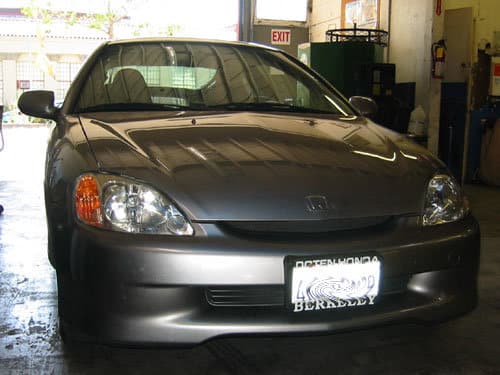We recently had a Honda Insight hybrid with an oil leak coming from the joint between the timing cover, engine block, and cylinder head. It wasn’t causing a lot of oil loss, but it was making a big mess. Our customer wanted to keep her Insight in top condition and authorized removing the timing cover (which requires removing the engine according to the factory manual) to reseal the timing cover. What better time to become better acquainted with the Insight and take a bunch of pictures of parts normally buried out of sight! Below are pictures and descriptions of our major Insight repair.
UV Dye Leak Detection
This is rather poor picture of the oil leak under UV light. Dye was added to the motor oil a couple hundred miles before this picture was taken. Our first thought was that the timing chain tensioner O-ring was leaking. It’s a fairly easy repair, so we replaced it and rechecked. Unfortunately, the leak continued, and the only other possible source of the oil leak was the timing cover/head/ block joint.
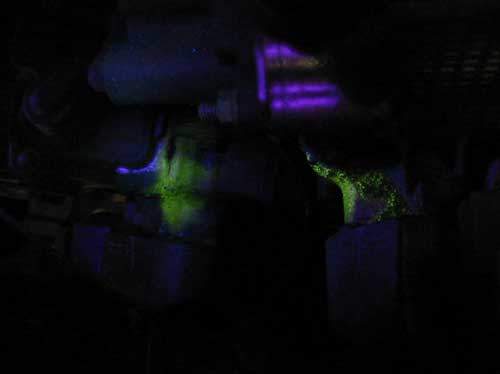
“Safing” the car
Before doing any service work to any hybrid, the battery must be disconnected. A shock from a battery this size can be fatal, so be sure you know what you are doing and follow the instructions in the factory manual. To disconnect the battery on the Insight, remove the small door on the floor of the rear cargo area. We wear high voltage “lineman’s gloves”, rated to 1000 Volts AC. This way we are protected in case there are any faults in the wiring. After flipping the switch, we remove the whole floor cover to test for voltage before starting work on the car. The Insight will store voltage in its capacitors even after the switch is turned off, so you must allow time for the capacitors to discharge before beginning work.

What’s under the cover
This is the Honda hybrid Insight battery pack with the rear cover removed. The fans and ducting are there to cool the battery, since it will heat up as it is charged and discharged. A high battery temperature will shorten the battery life. There are several battery temperature sensors, and presumably the computer will reduce battery activity if the temperature gets too high

Once the switch is thrown, there should be no power in the engine bay. However, there is no safe way to test for power in the engine bay, since a simple slip of the wrench while removing the cables at the IMA motor could lead to arcing and burns or electrocution. The Honda manual states that the rear cover should be removed after the switch is thrown, and power should be checked at the battery pack using lineman’s gloves. Remember that your voltmeter and leads should be in good condition, and rated to at least 500V, otherwise it could still give you a shock. It’s a good idea to be very aware of what all of your body parts are touching while you are checking for power.
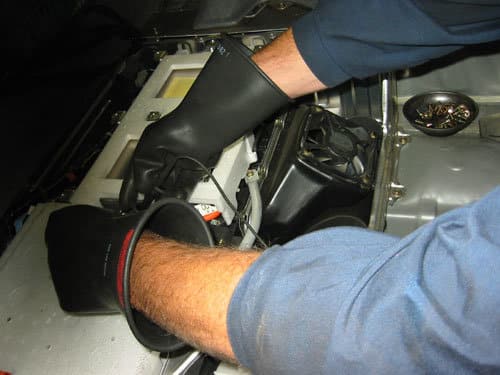
It’s a cramped little Honda, but still easy to repair
Like most Honda cars, the Insight’s engine compartment looks a little cramped. However, like most Hondas, the engineers have considered serviceability, and it’s not really as hard as it looks. The engine and transmission are easily removed from the Insight. In fact, it’s not really much different from removing an engine from any other Honda.
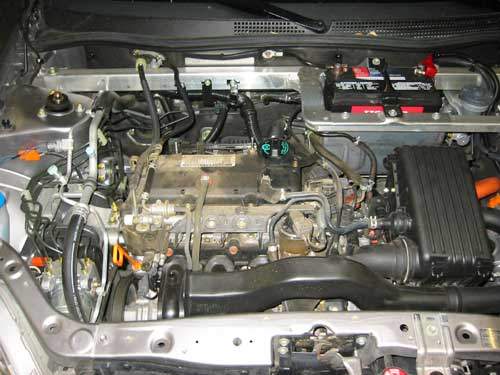
Removing the engine, hybrid motor, and manual transmission
Once the wiring, hoses, exhaust, axles, sub-frame, and other parts connected to both the body and the engine are removed, a cart is moved into position under the engine and transmission and the car is lowered so the engine and transmission are resting on the cart. With the cart in position, the motor mounts are unbolted, and the car is raised away, leaving the engine and transmission sitting on the cart.

Hybrid motor
The engine and transmission look pretty much like any other engine and transmission but sandwiched between the bell housing and the engine block there is a thin three phase electric motor/generator with three fat power cables entering through ominously labeled housing.
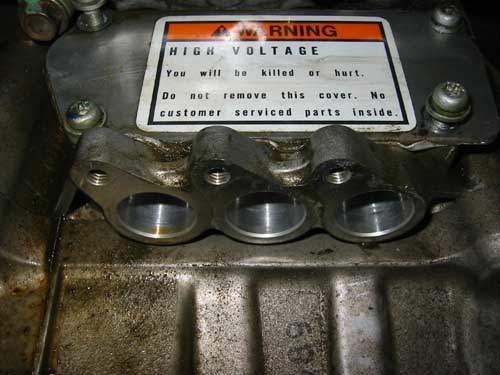
Motor sandwich
The area outlined in green is the motor/generator (IMA motor). The electrical connector is for the 3 commutation sensors that detect the position of the rotor. The Insight has a 3 cylinder gasoline engine, and 3 cylinder engines tend to vibrate quite a bit, especially at idle. Many engines use a counterweight on a shaft connected to the timing belt to cancel out the vibration. The Insight uses the IMA motor to cancel out the vibration by pulsing the IMA motor opposite the inertia of the engine. In order to do this, the MCM (motor control module) must know exactly where the engine is in its revolution.
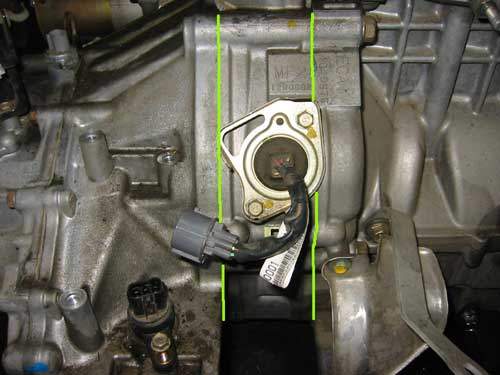
Integral exhaust manifold
The Insight does not have an exhaust manifold; instead, the exhaust runners are cast directly into the cylinder head. This is a pretty unique design, and I cannot think of any other car with an integral exhaust manifold. I imagine this was done to save weight. Above the exhaust manifold are the ignition coil packs. There is one coil pack per cylinder. The Insight uses a three-cylinder engine, so there are three coil packs. Under the coil packs are special indexed spark plugs.
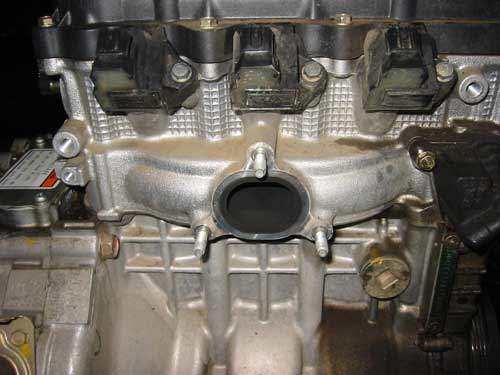
Indexed spark plugs for more complete combustion
There is a mark on the head near each of the spark plug holes the indicates with of three available indexed spark plugs should be used to that cylinder. The proper plug must be used for each cylinder to prevent misfire. A tune up with aftermarket plugs is likely to be disastrous on this car. This spark plug hole takes a “B” plug.

Regular injectors
On the other side of the head, there are three fuel injectors, sandwiched between the fuel rail and the cylinder head. The injectors are controlled by the computer using a duty cycle signal (percentage on time vs. percentage off time). When the computer wants to add more fuel, it increases the injector on-time, (also called pulse width). When the computer wants to reduce the amount of fuel, it reduces the on-time. The fuel is also controlled by the fuel pressure regulator. The fuel pressure regulator sits on top of the fuel rail. The vacuum line coming off the regulator goes to the intake manifold (missing in this picture). When the engine is under load, the vacuum will drop. A diaphragm in the fuel pressure regulator will respond to the vacuum and increase the fuel pressure.

Standard water pump
The Insight uses a conventional belt driven water pump and a thermostat to control temperature and flow. I suspect there will be electric water pumps controlled by temperature sensors on future Hybrids, which would eliminate the need for a drive belt, thermostat, front crank pulley and front crank seal (assuming the AC compressor is electric as well, which it is on the 2004-2009 Prius).

Auxiliary starter motor
Most of the time the Insight uses the electric motor / generator to start the ICE (Internal Combustion Engine), but if the main battery is discharged, or the weather is very cold, there is also an auxiliary starter motor that is powered by the auxiliary 12-volt battery. It’s important to check the aux. battery periodically, since you are less likely to notice the engine beginning to crank slowly as the battery loses capacity like you normally would with a conventional car. If the main battery and the auxiliary battery both become low on charge, you won’t be able to start your car. If this happens, you can get a jump start, just like any other car. However, you may have some difficulty convincing passing motorists this is the case. Many people are surprised to find out that a conventional car can give a hybrid a jump start.

Standard air conditioning system
The Insight uses a conventional air conditioning system with a compressor driven off a belt from the gas engine crank pully. This means that the engine must be running when the air conditioning is on. Owners who are accustomed to their hybrid’s gas engine shutting off when coming to stop signs are sometimes concerned when it continues to run when their air conditioning or defroster on. However, this is completely normal, and necessary for the AC to work. The 2004-2005 Prius and the 2006 Highlander Hybrid use an electrically driven compressor, so the IC engine does not need to be on for the AC to work (at least in theory, many of our customers report the IC engine will stay running when the AC is on). There is some talk of using a CO2, pressurized to 2500 PSI, as an environmentally friendly refrigerant in the future.
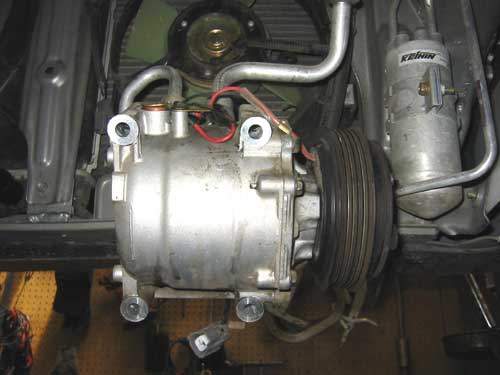
The Honda Insight hybrid is super light weight
The Insight’s frame is built entirely of aluminum and appears to be entirely hand welded. Very little steel can be found anywhere on the car. Most components are made of aluminum or plastic. Aluminum is usually considerably more expensive than steel, and hand welding is far more expensive that robotic welding. The Insight is no doubt a relatively expensive car to manufacture.
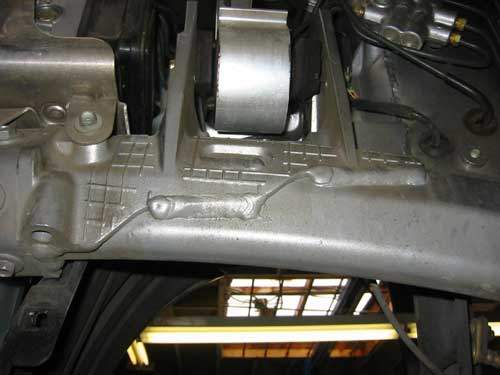
Thin motor oil
The Insight uses the thinnest motor oil of an car we work on. Generally, thinner oil will reduce drag and improve mileage. This is not the only reason to follow Honda’s oil viscosity recommendation. The bearing clearances on the Insight are very tight, in order to “hold” the very thin oil. Thicker, higher viscosity, oil may not be able to fit into the small bearing gaps used on the Insight. A wrong oil choice at a quick oil changer could do some serious damage to your engine. Currently, the ONLY vendor of 0W20 oil is Honda, so that’s where we buy our 0W20 oil.
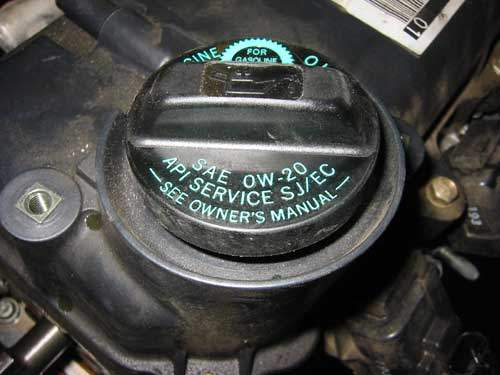
Giant catalytic converter
This is the catalytic converter. You may notice that it is about a foot and a half longer than the average import car’s converter. This is not because the Insight emits more that most cars. Just the opposite. The Insight runs a very lean air to fuel ratio, about 25% leaner than other cars. When very lean mixtures are used, the engine will produce more NOx emissions. NOx contributes to the orange hazy smog we see on sunny days. This converter reduces HC, CO, and NOx as do all converters on modern cars, but in addition it is also designed to absorb and store NOx during times when the internal combustion engine is running lean. At times the IC engine control unit will cause the mixture to go rich in order to reduce and release the NOx being stored in the converter. This keeps the overall NOx emissions low.

Lightweight plastic fuel tank
This is an all-plastic fuel tank. I imagine this was done to reduce weight. Not a bad idea for all cars, since many older fuel tanks develop rust that clogs the fuel system. The evaporative emissions system on the Insight is similar to most other cars. The EVAP system is designed to minimize the amount of fuel vapor escaping to the atmosphere. Fuel vapor is temporarily stored in charcoal filled canister until it can be purged from the canister into the engine and be burned. Even vapor displaced when filling the gas tank is stored in the canister until it can be used by the engine.

3 cylinder engine
This is the bottom end of the internal combustion engine. Three pistons move up and down in steel cylinder sleeves to turn the crank shaft. This engine, like many Honda engines, is a lightweight aluminum casting. I imagine the piston rings are thin and low tension (to reduce drag and increase mileage) and placed very close to the top of the piston the (to reduce the amount of air/fuel mixture trapped between the edge of the piston and top ring that will not burn). However, this is as far as we needed to go, so we did not get to disassemble the short block. It will have to be a mystery until Insights start to wear out and we get to take another one apart.
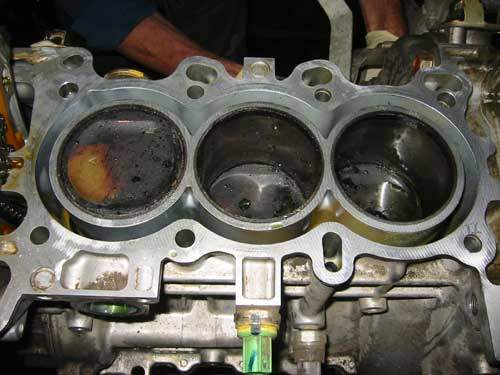
Regular Honda clutch
The clutch on the Insight is the same as any conventional car and is just as easily serviceable. There is no need to remove the engine or the hybrid system in any way other than disconnecting the battery for safety. The clutch job on the Insight is just as easy as a clutch job on a Civic. This picture is the flywheel (part of the clutch). It’s mounted at the end of the crankshaft after the electric motor, so it is easily accessible after the transmission is removed.
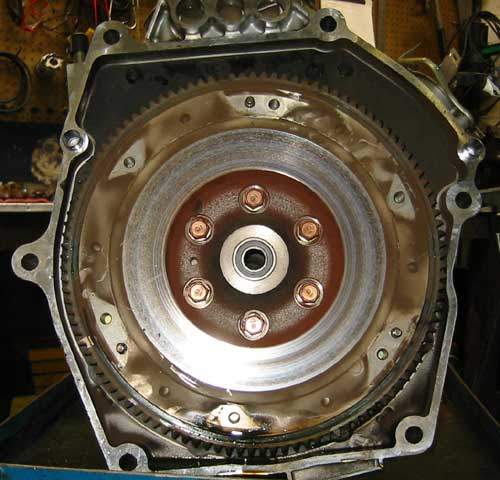
Typical transmission
This is the Insight transmission sitting on the bench. It too is pretty unremarkable; it’s just like any other transmission. The sensor on the left is the vehicle speed sensor (VSS). It generates a 0-to-5-volt pulse as the output shaft spins. The faster the output shaft (and wheels) spin, the more frequent the pulses become. The VSS output is used for the speedometer (eliminating the speedometer cable) and the for the engine control computer. This sensor is not unique to the Insight though. All modern Hondas use a similar sensor.

Beefy timing chain guides
This is ICE engine block stripped to the casting, crank, rods and pistons. The short block is aluminum is all aluminum with the steel cylinder sleeves. The timing chain guides are made from plastic with a robust aluminum backing. Looks like Honda will avoid all the timing chain troubles motors like Toyota’s 22RE had. The reluctor for the crankshaft position sensor is mounted behind the lower timing chain sprocket and the sensor is mounted in the side of the oil pan. The main bearing caps are webbed together for added rigidity. The casting quality is excellent. It’s very smooth, even in inaccessible areas, and there is no porosity evident. Honda did have some trouble with porosity on the J35A V6 motor, but I doubt this casting will ever have trouble; the quality really is very impressive.

This is the cam and some of the other timing components that had to be removed to reseal the timing cover.

Screw and jam nut valve adjustment
The valves on the Insight are screw and jamb nut style, like many Hondas. Up until 1993, most Honda’s had a valve adjustment interval of every 15,000 miles. In 1994 most switched to an every 30,000-mile interval. In 2001, despite still using the screw and jamb nut style valve adjustment, Honda went to a 105,000-mile interval on most of their cars, including the Insight. Honda has been wrong about their valve adjustment intervals before (the 1997-2001 CRV being a prime example), but it’s too early to tell whether the 105K interval will prove detrimental to the long-term health of the Insight’s engine.

Electronic EGR valve
This the EGR valve for the Insight’s internal combustion engine. The EGR system is designed to reduce NOx. EGR stands for Exhaust Gas Recirculation and works by routing exhaust gas (which is inert having already been burned) into the intake. The inert gas in the combustion chamber reduces combustion chamber pressures and temperatures. High combustion chamber pressures and temperatures cause high NOx, so by reducing them, NOx is also reduced. Most non-hybrid cars also have EGR systems. Most EGR valves are actuated with a vacuum signal modulated by the engine control computer or an exhaust backpressure modulator. This EGR valve is electronically controlled and monitored. I’ve heard American cars have been using this type of valve for a while, but it’s relatively new for Japanese cars. Many of the newer Hondas now have a similar EGR valve.
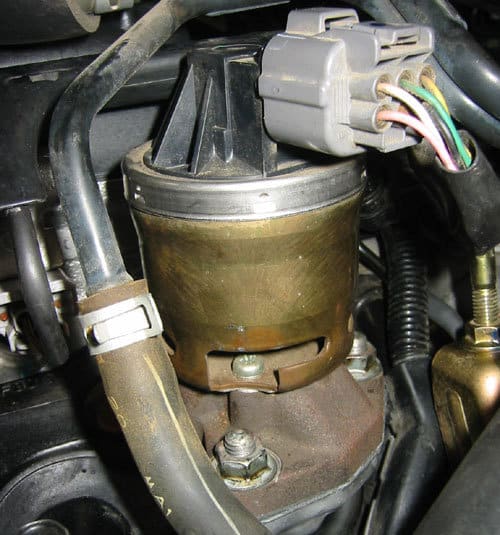
Clearly marked high voltage cables
All high voltage cables are marked in orange, just as all air bag wiring is marked in yellow. This is a picture looking up into the engine compartment with the engine removed. Can you spot the high voltage cable? There are actually 3 cables in the sheath. All of the control of for the electric motor is in the back of the car, only the output cables for the motor go up to the front, which makes for a cleaner engine compartment.

Electronic power steering
This is the electrical assist power steering rack. Since the internal combustion engine does not run all the time, a conventional hydraulic assisted power steering rack with a belt driven pump will not work for the Insight or other hybrids. This unit is made by Showa, a subsidiary of Honda which makes many suspension and steering parts for Honda cars. These electric servo power steering racks have been on the Insights since 2001, and I have not heard of any failures yet. The first couple years of the first generation of the Toyota Prius had problems with their electric racks as well as their steering control computers, but the problems seem to have been ironed out in later years.
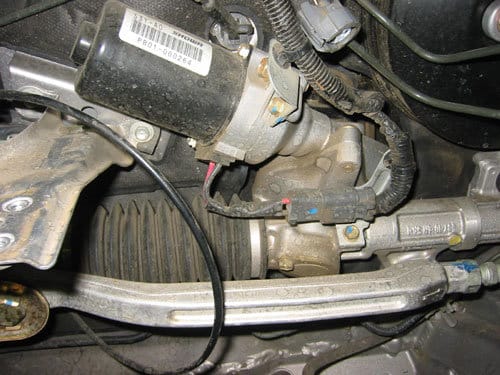
Mostly normal brake system
I wish I had taken some pictures of the brake components. The Insight’s brakes are conventional for the most part. The Insight does not really have regenerative braking; it’s more like regenerative deceleration. The amount of battery charging will actually decrease when you apply the brakes, unlike the Prius. One special brake feature is a pressure/vacuum sensor that monitors the vacuum in the brake booster. The Insight’s ICE will start if the booster vacuum is insufficient to provide good brake assist.
Anti-creep system
Another special brake feature on the Insights with CVT transmissions is the “creep aid solenoid valve”, which is an electronically controlled valve that holds pressure in the rear brake lines when the car is stopped, in order to keep the rear brakes applied until you’re ready to accelerate.
The front brakes are just like any other car. The rotors are steel and the service manual states they can be machined, up to .080″ under the “new” specification.
The rear drum brakes are also ordinary, other than the aluminum rear brake drum. The drum new drum is .039″ over the service limit, which is similar to most other cars. Honda does not say whether they recommend machining or not. The service manual simply says, “If the drums are over the service limit, replace”. It does not say whether they recommend machining if the drum is scored or out of round and it’s under the service limit. Common sense and experience dictate the drums can be machined up to the service limit. Aluminum is actually very easy to machine. However, it’s a good idea to use aluminum cutting oil to prevent the cutting bit from loading up and starting to “smear” instead of cutting. Aluminum cutting oil is available from Goodson, Enco, MSC, and many other suppliers.
The engine repair is now complete
Sealed, scrubbed, and shiny. This engine hasn’t been this clean since 2002.Time to “reverse order of disassembly”.
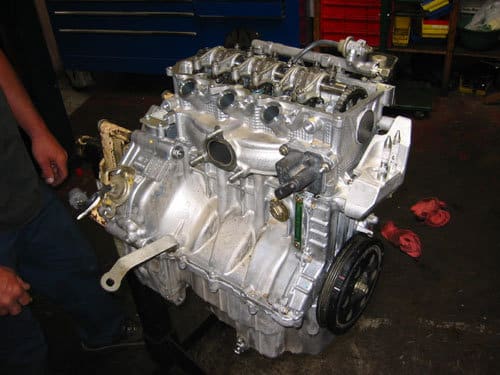
That’s the end of the Insight tour. Everything’s back together and all the fluids are full — time to power up!
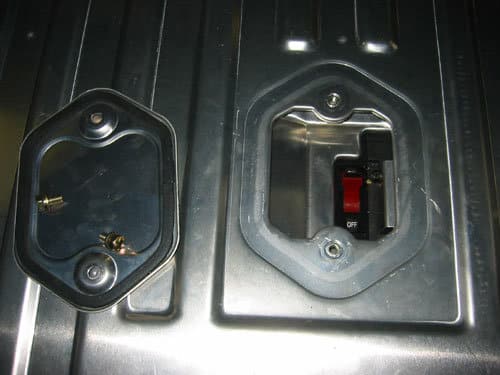
It’s all about the details
Just about done — every fluid checked and double checked every connector with its mate, every hose and harness snapped into their guides. Sandor even likes to install all of the bolts back in their original holes. When you do a large job like this, you might have 20 of one size of bolt. However, some might be gray, some might be black, some might be gold colored. They might all be the same type with the same rating, but Sandor puts the gray ones where the gray ones were, the black ones where the black ones were, and the gold-colored ones where the gold colored were.
Will the driver ever notice little details like this? Probably not. Will it be near impossible for another mechanic to tell the engine’s been out, you bet. It’s this attention to detail that allows Sandor do 3 or 4 major engine projects every week, comeback free.

One happy Honda Insight!
After several test drives and a wash, this Insight’s ready to go home.
